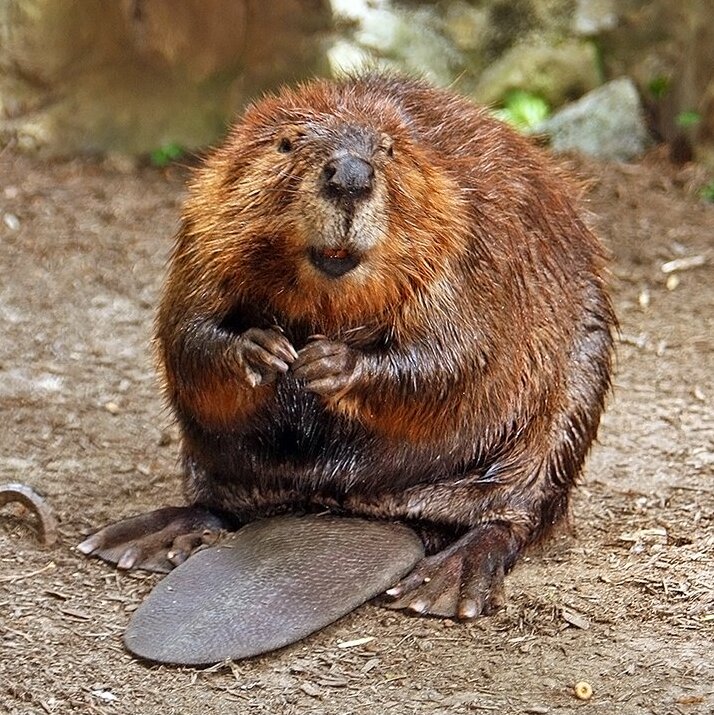Not far from a spot where a beaver toppled a tree on to a power line, sparking a brush fire last summer, four volunteers work to ensure the industrious rodents can’t chew through another pine.
They’ve spent the morning behind a townhouse complex which abuts Kanaka Creek wrapping trees with wire to protect them from a family of beavers.
“Coexistence is the new strategy,” says Leslie Fox, the executive director of the Association for the Protection of Fur-Bearing Animals.
The “Fur-Bearer Defenders” were called in after several trees nibbled by the semi-aquatic animals fell on to townhouses.
Instead of calling a trapper, the strata opted for a more humane approach.
“I think trapping’s days are numbered,” said Fox.
“One of the things we’ve noticed with trapping is the conflict it causes in the urban environment.
“What ends up happening is people’s pets get caught. It doesn’t solve the problem and it creates a danger for people who live near [the traps].”
The non-profit group works across Canada to educate municipalities and land owners about simple, non-lethal alternatives to thwarting problems caused by beavers.
Surrounding trees with cylindrical cages prevents beavers from chewing them. Instead of tearing a beaver’s home apart, pipes can be installed in dams to control flooding.
It’s really a win-win, say the volunteers, because the animals get to stay in their ecosystems and it’s cheaper for the municipality.
It cost just $300 to wrap 50 trees behind the townhouse complex.
“By breaking the dam, many people think that’s going to discourage the beaver. But what actually ends up happening is beavers just take more trees. So you just make the problem worse,” said Fox.
The Association for the Protection of Fur-Bearing Animals has managed to get several cities in the Lower Mainland to change the way they deal with beavers.
Port Coquitlam, Coquitlam and Mission no longer use lethal methods to control beavers.
Mission, like many other municipalities, had a long history of manually breaking apart dams, as well as trapping and killing beavers.
But since last year, Mission has embraced methods that prevent beavers from building a dam in the first place.
Besides tree cages and pipes in dams, Mission has also been building wire fences around culvert intakes, to interrupt the beavers’ natural instinct to build where there’s current and the sound of flowing water.
Dale Vinnish, the public works operations supervisor told Black Press last year, the devices “work awesome.”
“We don’t have to trap beavers. They moved elsewhere. They’re not causing a problem,” Vinnish said.
The “beaver deceivers,” at $400-$600 apiece and built in one day, save the District of Mission thousands of dollars, because workers no longer have to pull apart dams.
Previously, the municipality would break down two to three dams daily, several days a week, in addition to paying for the capturing and killing of about a dozen beavers annually.
Maple Ridge and Pitt Meadows however have yet to abandon lethal trapping.
Pitt Meadows operation supervisor Randy Evans remains skeptical that pipes in beaver dams and culvert fences will solve their problems.
He wants an engineer to sign off on the devices before the city considers using them but none of the companies who’ve approached the city will do so.
“If you put something like a dam or diversion in a watercourse, you need to have it engineered because you’ve got to accept the liability of what you are putting in there,” said Evans.
“It could stop the flow as well because debris gets hung up in these kinds of things and then it floods.”
Pitt Meadows already wraps trees with wire but continues to routinely tear down dams in a mostly futile effort to get beavers to relocate.
A licensed trapper is called in only when there’s a risk of serious flooding but Evans doesn’t have a figure on how many beavers are killed in the city annually.
“What the beaver listens for is water movement and we really don’t have a lot of that because it’s so flat,” said Evans.
“These devices won’t work here. I know they won’t because our system is somewhat unique.”
The District of Maple Ridge did not trap any beavers last year and only does so with approval from the Ministry of Environment.
Trapping is a last resort, said Russ Carmichael, the district’s director of engineering operations.
“We really try to avoid drastic measures.”

